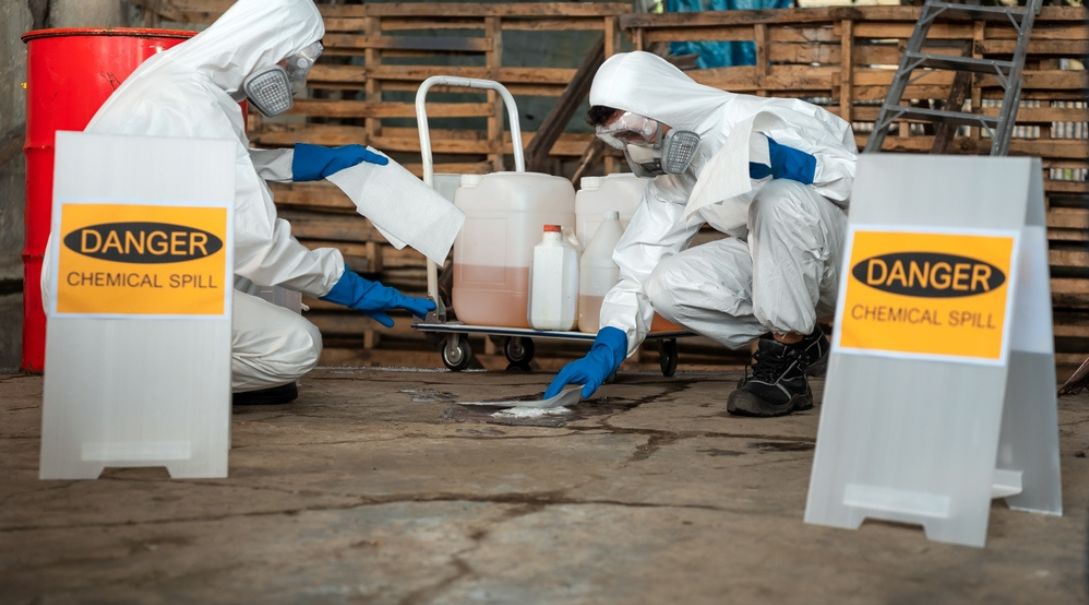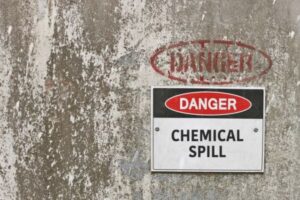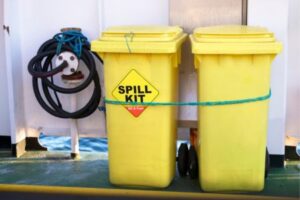When chemical spills in warehouses occur, there needs to be a quick and effective spill response to protect employees, property, and the environment.
Our comprehensive guide provides a step-by-step approach to managing chemical spills in warehouses. It will help warehouse operators, safety managers, and employees and effectively aid those experiencing a chemical spill.
NOTE: This information is key to ensuring an ongoing safe working environment. If you are experiencing an emergency due to a chemical spill in your warehouse, promptly contact emergency services professionals, such as AOTC.
Table of Contents
Understanding the Risks of Chemical Spills
Warehouses store and move all kinds of products, including chemicals that can be dangerous to people and the environment. They are very busy with lots of activity, and chemical spills can occur anytime.
Chemical spills in warehouses can pose health risks to employees, potential damage to property (including merchandise and the building itself), and environmental impacts.
Risk assessment and implementing standard safety protocols are critical in preventing spills.
NOTE: If you are in a hurry – underneath this section is the step-by-step guide, including answers to “What do you do if spillage occurs?” and how to clean up chemical spills in the workplace.
Immediate Actions Upon Identifying a Chemical Spill
The first steps after detecting chemical spills in warehouses should be taken quickly.
Ensure personal safety. The person(s) who identifies the spill should first get themselves to safety and then immediately warn others to stay out of the area.
Assess the spill’s scope. Is it a 5-gallon bucket, a whole pallet of chemicals, or more than that? The management of the spill will vary depending on the scope.
NOTE: It is highly recommended to contact emergency services if the chemical spill is particularly large or dangerous.
Securing the Area and Initial Assessment
Next, the spill must be stopped, and the area must be secured to prevent further exposure or spread, including an initial assessment to verify the chemical that was spilled, its approximate size and spread, the flow rate, and the areas it affected in the warehouse.
Ensure the area is cleared of non-essential personnel and barricade the affected area as much as possible to keep others from entering and potentially getting injured.
The best scenario is if the spill is easily identifiable by a marked container. If an unknown chemical spills in the warehouse, those with proper knowledge or certification in chemical identification should be sought out. General workers should not risk an attempt to identify an unknown chemical.
Once the chemical is verified, potential hazards associated with it should be identified. Hazards may include danger upon inhalation, exposure to skin, or ingestion.
This information will inform subsequent actions in managing the chemical spill in the warehouse.
Notifying Emergency Response Teams and Management
Prompt communication with internal and external emergency response teams, including warehouse management, is crucial. Without prompt communication, response times can be delayed, and mistakes can be made that can harm people and damage property.
When emergency response teams are notified, this will mobilize specialized spill response efforts and comply with regulatory reporting requirements.
Implementing Containment and Cleanup Procedures
After the appropriate internal and external terms and management are notified, the spill must be contained to prevent further contamination.
If the spill is ongoing, find the source. Actions could include:
- Closing an emergency shut-off switch.
- Turning a valve.
- Plugging a hole in a container.
Once the spill is stopped, it is time to contain it. While the team gathers containment materials and equipment, others should move any product, materials, and equipment near the spill inside the warehouse so it does not get spoiled or damaged by the spreading of the chemical or during containment and cleanup.
Here are typical containment materials and equipment for chemical spills:
- 55-gallon Drum
- Spill Absorbent Pads
- Absorbent Socks
- Acid Neutralizer Shakers
- Flexible Containment Tray
- Nitrile Gloves
- Goggles
- Disposable Poly Bags
- Ties
- Absorbent Granular Substance
- Absorbent Spill Mat
- Fine Fiber Absorbent Rolls
- Brush and Scoop
- Overpack Drums
What and how much materials and equipment you will use to clean up will depend on whether it is a minor or a major spill and the type of chemical.
NOTE: Check to see if there are any drains in the spill area. Cover them immediately or surround them with a spill sock or other absorbent to stop the chemical from entering the drainage system. This will be part of the reporting process if a hazardous material has already entered a storm drain (or poses any other environmental threat).
Minor non-hazardous spills are straightforward and often require only a few materials, such as a mop and a shop vac.
However, many chemical spills are treated differently. These may include flammable spills, acid spills, oxidizer spills, acutely toxic material spills, and chemicals under pressure spills, among others.
Confirm what chemical you are working with before proceeding to cleanup and waste disposal.
Key guidelines are needed to make the management as safe as possible.
Before any toxic spill cleanup, the chemical will need to be neutralized safely per guidelines. The American Chemical Society recommends:
- Neutralize acids with sodium bicarbonate
- Neutralize bases with citric acid
Now, it is time to remove the spilled chemicals. This should be performed with proper safety equipment and per hazmat protocols.
Utilizing Spill Kits and Personal Protective Equipment (PPE)
Every warehouse should have well-stocked spill kits and Personal Protective Equipment (PPE). These are standards for cleaning up chemical spills in warehouses.
The spill team will remove necessary items from the spill kit (many listed above) and gather larger items, such as bags of granular absorbent. Often, an instruction sheet detailing how to properly use the items during cleanup is included in in-house spill kits.
Gear up with the appropriate PPE. Gloves and goggles protect hands and eyes. Depending on the spilled chemical’s properties, more PPE may be necessary, including masks, gowns, or a protective breathing apparatus. Heavy-duty hazmat suits may also be required.
When hazardous chemicals are involved, there are health risks. It is advisable to consult a professional emergency spill response and remediation company in these situations.
Cleanup and Waste Disposal
After ensuring the chemical is contained and wearing the correct PPE, follow spill response procedures, focusing on safe handling, appropriate neutralization methods, and proper disposal of contaminated materials in accordance with environmental regulations.
Note: Many types of neutralizers for bases and acids will change color once they are neutralized.
Here is an overview of how to clean up chemical spills in the workplace:
- Pour absorbent from the outside of the spill to the center, reducing the chance of spread or splash. Spill pillows or other absorbent pads may be utilized depending on available materials and the spilled chemical.
- After the spilled chemical has been neutralized and absorbed, use a brush and scoop to place the materials into an appropriate container. Polyethylene bags can be used for small spills, while larger ones require buckets or drums with liners.
- Identify the materials as hazardous waste. This is often done with stickers or hazmat bags/containers.
- Properly dispose of hazardous waste per the spill response plan and in accordance with environmental regulations.
Once this is complete, the area needs to be decontaminated and restored.
Decontamination and Area Restoration
The warehouse will need to be safely returned to operational status. Here are the recommended steps for decontamination and restoration:
Area ventilation: ventilate the area well and use industrial fans if needed.
Surface cleaning: the area should be treated with the right equipment or chemicals to remove the adverse effects of the spill. Even if the spill is no longer visible, there could still be hazards.
This part of decontamination and restoration could involve applying industrial degreasers to eliminate slipping hazards or sanitizers to neutralize any potential remaining chemicals/residue after cleanup. The parameters of the spill will determine this.
Worker Safety: workers may need to be disinfected. If anyone were injured in the spill, they would need to be decontaminated before treatment. Their clothes may need to be disposed of, too.
Tools and Equipment Cleanup: all tools and equipment used in the chemical spill cleanup should be cleaned. Spill kits and other materials should be restocked.
Monitoring: the area should be monitored for residual hazards after completing area restoration.
Documentation and Reporting
The chemical spill should then be documented. Companies will typically have an internal incident report, including details such as:
- The date and time the incident occurred
- The substance(s) involved in the spill
- The location of the spill
- The extent and quantity of the chemical spill
- The hazards posed by the chemical spill
- The actions that were taken to both contain and clean up the spill
Internal reporting: complete incident report and/or other documentation required by the warehouse and/or company.
Note: If the chemical was a hazardous substance and of a reportable quantity (RQ) as designated by the parameters defined by the EPA — federal law requires reporting any hazardous substance spill or release that exceeds its RQ to the National Response Center (800-424-8802).
Additional external documentation and reporting: state and local governments also have their own reporting requirements on chemical spills. Ensure all state and local regulations are followed, including any necessary follow-ups with environmental agencies.
Accurate, detailed documentation and reporting ensure legal compliance and support continuous improvement in spill response protocols.
Reviewing and Improving Spill Response Procedures
After chemical spills in warehouses occur, the company’s chemical spill response procedures should be reviewed for effectiveness and possible areas of improvement. Good strategies for this include:
- Conducting a debriefing with all participants in the spill response
- Identifying any lessons learned in the spill response
- Making necessary adjustments to prevention and response plans
These actions are key in the mitigation of future risks.
Developing a Chemical Spill Response Plan
A chemical response plan should be customized for your warehouse.
However, there are key components to all effective chemical spill response plans, including:
- Identification of Potential Hazards – assess and document storage, handling, production, and waste storage areas; review transport routes and manufacturing equipment; review the types of chemicals stored or used, their volume, and hazardous properties
- Detailed Emergency Procedures – including comprehensive actions for response to Stop the Spill, Contain the Spill, Isolate the Area, Report the Spill, and Clean up the Spill.
- Employee Training – ensure and maintain training from qualified, experienced professionals regarding risks with chemicals in the workplace, how to prevent spills, and correct procedures to clean up spills.
AOTC’s Role in Enhancing Chemical Spill Preparedness
If you are a warehouse operator, AOTC is here for you. Our services include specialized training, consultation, and support in chemical spill management.
AOTC has extensive experience creating safer work environments through proactive safety measures and compliance with regulatory standards. We offer a wide range of workplace safety, compliance training, and educational services, including on-site 8, 24, and 40-hour HAZWOPER training.
We’re there when you need us, including if you experience chemical spills in warehouses.
AOTC provides trusted, reliable, and affordable 24/7 emergency response services in FL, AL, and GA. Contact us today to get started.


